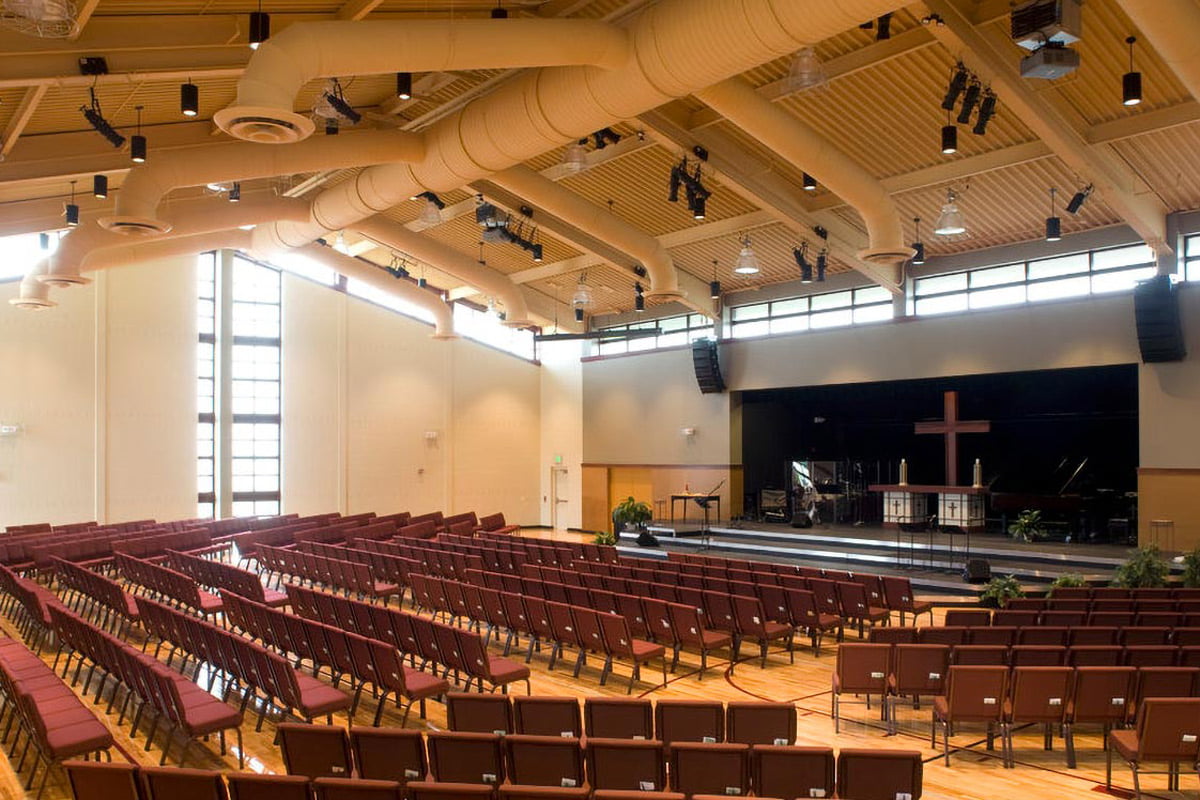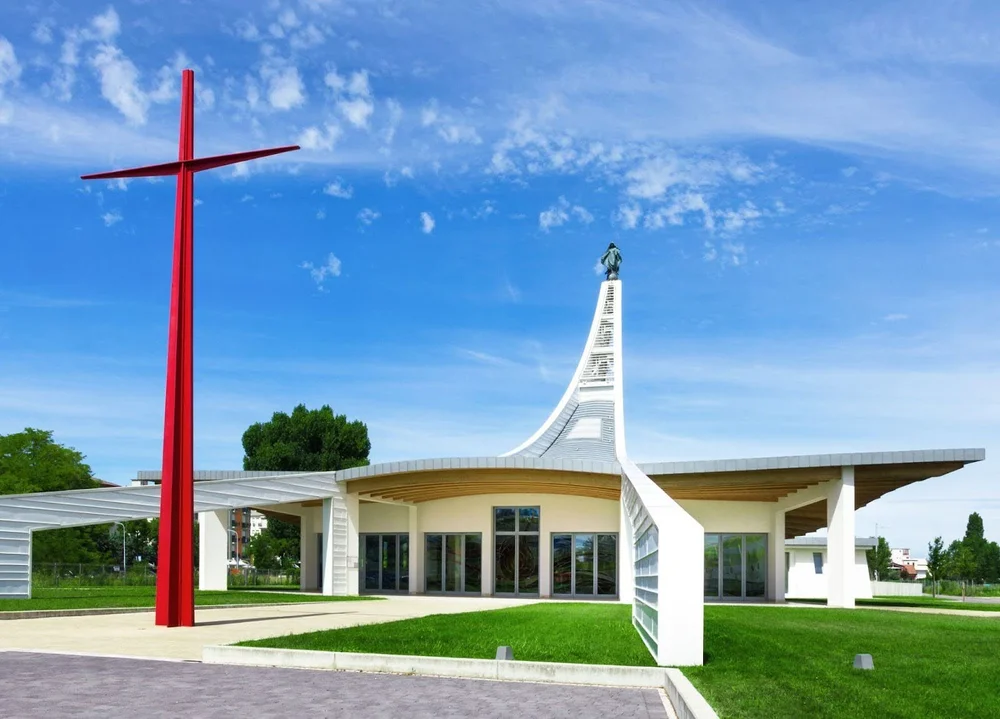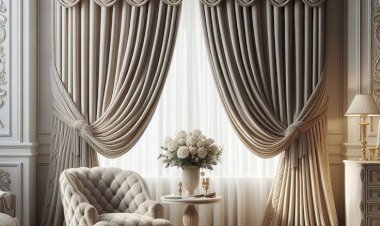A Complete Guide to Church Interior Design Ideas & Practical Advice
Discover expert tips, trends, costs, and design ideas for church interiors. Create a welcoming, functional, and faith-filled worship space.

Church interior design goes beyond decoration—it’s about shaping an environment that feels peaceful, welcoming, and spiritually uplifting for everyone who enters. Every detail matters: the arrangement of seating influences community and connection, lighting sets the mood for prayer and reflection, and wall colors can either inspire calm or emphasize sacred symbolism. Whether you’re building a new church or restoring a historic one, understanding the essentials of interior design helps create a space where worship feels meaningful and memorable.
➤ In this article, we’ll share expert insights, realistic cost considerations, current design trends, and practical ideas that will help your church foster a warm, inviting, and deeply spiritual atmosphere.
History and Tradition in Church Interior Design

Image source: i.pinimg.com
Church interior design is deeply rooted in centuries of architectural and cultural tradition. In the United States, many historic churches draw inspiration from European styles such as Gothic, Romanesque, Renaissance, and Baroque, each reflecting a distinct spiritual and artistic vision.
-
Gothic churches often feature pointed arches, ribbed vaults, and stained glass windows that filter colorful light into sacred spaces, symbolizing divine presence.
-
Romanesque styles, with their thick stone walls and rounded arches, convey a sense of strength and permanence.
-
Baroque interiors are typically more ornate, incorporating gilded altars, sculpted columns, and elaborate frescoes that emphasize grandeur and glory.
According to the National Trust for Historic Preservation, a significant number of American churches built before the mid-20th century still retain their original craftsmanship—stone masonry, wood carvings, and decorative metalwork. Preserving these elements not only safeguards history but also strengthens a congregation’s identity by connecting present worshippers to past generations.
Today, many modern congregations blend tradition with contemporary needs. For example, churches may preserve historic stained glass while integrating modern seating, lighting, or audio systems to accommodate evolving forms of worship. The most thoughtful designs strike a balance—honoring tradition while ensuring functionality for today’s community life.
If you’re exploring other creative design inspirations beyond churches, check out our guide on Ice Cream Shop Interior Design: Create an Instagrammable & Brand-Friendly Space
The Importance of Lighting in Church Interiors

Image source: blogger.googleusercontent.com
Lighting plays a far greater role in churches than simply providing visibility—it shapes the spiritual and emotional atmosphere of worship. A thoughtfully lit church interior can inspire reverence, highlight sacred architecture, and foster a sense of community.
Symbolism and Natural Light
For centuries, churches have relied on natural light to create meaning and symbolism. Stained glass windows, for example, are not only decorative but also spiritual storytellers. As sunlight filters through the colored glass, it bathes the interior in hues that symbolize themes like hope, purity, and divine presence. This use of light connects worshippers to centuries of tradition and faith.
Modern Approaches: Energy-Efficient Lighting
Today, many churches balance tradition with sustainability. LED lighting systems have become popular for their efficiency and flexibility. According to the U.S. Department of Energy, switching from conventional bulbs to LEDs can reduce electricity consumption by up to 75% while lasting significantly longer. This allows churches to cut costs and direct more resources toward community work and spiritual activities.
Versatility in Worship and Events
Beyond energy savings, modern lighting systems offer practical benefits. Some churches, such as Trinity Chapel in Michigan, use programmable lighting controls to adapt brightness and color temperature depending on the occasion—whether it’s a quiet Sunday service, a wedding ceremony, or a lively concert. This adaptability ensures the space always feels appropriate and inviting.
The Role of Layered Lighting
Good church interior design incorporates layered lighting:
-
Ambient lighting ensures overall brightness and comfort.
-
Task lighting provides focus where needed, such as on the pulpit, altar, or choir.
-
Accent lighting highlights architectural details, stained glass, or sacred art.
Together, these layers create a balance of reverence, warmth, and visibility—helping churches remain both functional and spiritually uplifting.
Seating Layouts That Make Sense

Image source: i.pinimg.com
Seating arrangements shape how congregants connect with one another and engage with the worship experience. Traditional fixed pews reflect a sense of heritage and continuity, while movable chairs provide flexibility for modern needs—whether it’s small group gatherings, concerts, or community events.
Many contemporary churches are experimenting with alternative layouts, such as semi-circular or circular seating, to encourage a greater sense of community and participation. Studies in church design show that inclusive layouts can improve visibility, acoustics, and interpersonal connection, making worship feel more interactive rather than spectator-driven.
Accessibility is also essential. ADA (Americans with Disabilities Act) guidelines emphasize providing wheelchair-accessible seating integrated into the main congregation, rather than isolating it. Good design ensures clear sightlines, physical comfort, and ease of movement, creating a welcoming environment for everyone.
Ultimately, thoughtful seating design isn’t just about furniture—it’s about shaping an atmosphere of inclusivity, participation, and shared worship.
Choosing the Right Color Scheme
Image source: encrypted-tbn0.gstatic.com
Color plays a powerful role in shaping emotion, atmosphere, and focus within worship spaces. Soft, natural tones such as beige, ivory, sage, and sky blue are especially effective for creating a sense of calm, serenity, and openness. These hues are frequently used in churches, temples, and meditation halls to encourage reflection and spiritual focus.
Brighter colors—such as deep reds, golds, or vibrant blues—should be applied with intention. They work best in accents like banners, stained glass, murals, or seasonal décor, where they can highlight key religious symbols or celebrations without overwhelming the sacred environment.
According to church design consultants and interior studies on worship environments, neutral color palettes are especially valued for their ability to promote stillness and reduce distraction. Many traditions also incorporate colors that correspond with liturgical or ritual seasons (such as purple for Advent and Lent, or white for Easter and Christmas in Christian churches), ensuring that the visual experience supports spiritual meaning as well as aesthetics.
The goal is balance: using soothing neutrals as the foundation, with thoughtful accents of brighter hues to guide the eye and reinforce the spiritual message of the space.
Flooring Options That Work for Worship

Image source: i.pinimg.com
Choosing the right flooring for a church goes beyond looks—it must support durability, acoustics, safety, and the spiritual atmosphere of the space. Since worship areas are high-traffic zones, flooring should balance practicality with reverence.
Key Considerations for Church Flooring
-
Durability: Floors should withstand heavy foot traffic, furniture movement, and regular cleaning.
-
Acoustics: Sound absorption is essential for sermons, choirs, and music. The right flooring helps reduce echo while preserving clarity.
-
Safety: Slip-resistant materials protect congregants of all ages.
-
Aesthetics: Flooring contributes to the overall warmth and sacred feel of the sanctuary.
Popular Flooring Options
-
Carpet & Carpet Tiles – Widely chosen for worship spaces, carpet softens acoustics, reduces echoes, and provides comfort underfoot. Carpet tiles are especially practical since damaged sections can be replaced individually, lowering long-term maintenance costs.
-
Hardwood – Brings warmth and timeless beauty to sanctuaries. While more expensive upfront, it adds elegance and can be refinished multiple times to extend its lifespan.
-
Stone & Tile – Extremely durable and long-lasting, stone flooring (such as marble, slate, or ceramic tile) adds grandeur to traditional church interiors. However, it can create echo, so pairing with area rugs or acoustic panels may be necessary.
-
Vinyl & Luxury Vinyl Tile (LVT) – Increasingly popular for multipurpose church facilities, LVT offers durability, water resistance, and a wide range of designs that can mimic wood or stone at a lower cost.
Final Thought
Well-planned church flooring reflects not just the style of the sanctuary, but also the needs of the congregation. From enhancing worship acoustics to ensuring safety and comfort, the right flooring supports both the practical and spiritual goals of a church community.
Just like churches, salons also thrive on ambiance. If you’re looking for inspiration beyond worship spaces, check out these Nail Salon Interior Design Ideas: 10 Stylish Themes That Wow Clients (2025 Guide
Designing a Welcoming Entrance Area

Image source: i.pinimg.com
The entrance is the very first impression visitors have of a church—it quietly communicates hospitality before a single word is spoken. A thoughtfully designed entryway should feel open, inviting, and easy to navigate.
Key elements like clear signage, warm lighting, and comfortable seating instantly help newcomers feel at ease. Bulletin boards or digital displays can provide useful information without overwhelming guests. Even small touches—such as greeters at the door, fresh flowers, or a designated area for first-time visitors—make the space more approachable and friendly.
Research on guest experiences in faith communities consistently shows that first impressions strongly influence whether visitors return. Many church consultants suggest that people often decide within the first 7–10 minutes if they’ll come back, long before the sermon even begins. That means the entryway plays a crucial role in fostering connection, setting the tone for worship, and ensuring every person feels genuinely welcomed.
Altar and Sanctuary Design

Image source: i.pinimg.com
The altar is the heart of every church, serving as both the symbolic and spiritual center of worship. Whether in a traditional cathedral or a modern sanctuary, it must remain visually prominent and inviting. Designers often elevate the altar on a raised platform or frame it with meaningful architectural elements such as a cross backdrop, stained glass, or finely crafted woodwork to naturally draw the congregation’s focus.
For example, some churches integrate natural materials like wood and stone to convey warmth, simplicity, and a connection to creation. This approach reflects a timeless design philosophy while allowing each church to express its own character.
Equally important is the overall sanctuary environment. A well-planned space balances beauty with function: acoustics should carry both spoken word and music clearly, while lighting should create atmosphere without distraction. Thoughtful use of sound systems, ambient lighting, and even eco-friendly design choices ensures that the sanctuary supports worshippers in prayer, reflection, and celebration.
In short, altar and sanctuary design is about creating a space that is visually inspiring, spiritually meaningful, and practically supportive of worship.
Sound and Acoustics in Church Design

Image source: i.pinimg.com
Acoustics play a central role in shaping the worship experience. Clear sound enhances music, preaching, and congregational participation, while poor acoustics can make even the most moving sermon or choir performance difficult to follow.
Churches often feature high ceilings, domes, and large expanses of stone, wood, or glass—beautiful for architecture, but prone to causing echoes and long reverberation times. This can blur spoken words or make music sound muddled.
To achieve balanced sound, modern church design integrates a combination of architectural planning and acoustic treatments:
-
Sound-absorbing materials – Acoustic panels, fabric wall coverings, and carpet runners can reduce echo without compromising aesthetics.
-
Ceiling treatments – Acoustic ceiling tiles or diffusers help control how sound waves travel in large spaces.
-
Speaker and microphone placement – Proper positioning ensures that sound reaches every seat evenly, minimizing feedback and “dead spots.”
-
Blending natural and electronic acoustics – A well-designed space balances the natural resonance of the building with sound reinforcement systems, so music feels rich and voices remain intelligible.
Many architects and sound consultants now emphasize acoustic planning as early as the design stage, rather than treating it as an afterthought. This approach not only improves worship quality but also ensures that the building serves multiple purposes—from music concerts to community gatherings—with clarity and warmth.
Looking to refresh your space with calming accents? Check out our guide on Blue Green Decorative Pillows: Style Tips, Color Pairing & Where to Buy for the perfect mix of elegance and comfort.
Decorating With Symbolic Art and Imagery
Image source: encrypted-tbn0.gstatic.com
Art in churches has long served as more than decoration—it reflects theology, faith, and cultural heritage. Stained glass windows, mosaics, banners, and murals often tell stories from the Bible or honor saints, offering worshippers visual reminders of sacred teachings. For instance, many Lutheran churches in the U.S., including Christ Lutheran Church in Minnesota, feature abstract stained-glass designs that symbolize themes such as resurrection, hope, and renewal.
In contemporary settings, churches are blending tradition with innovation. Some incorporate digital projection art, minimalist symbolism, or interactive displays to connect with younger audiences while still maintaining reverence. The goal of church interior design is not simply aesthetic; it should inspire reflection and elevate spiritual focus without overwhelming or distracting worshippers.
When thoughtfully integrated, symbolic art becomes a bridge between past and present—teaching theology, nurturing devotion, and enriching the worship experience for every generation.
Creating Spaces for Prayer and Reflection

Image source: i.pinimg.com
Designated areas for prayer and quiet reflection are vital in churches, as they provide members with a place for personal worship, meditation, and spiritual rest. These spaces can take many forms—such as side chapels, meditation rooms, or small alcoves with soft seating, warm lighting, and calming décor.
Well-designed prayer spaces are usually located in areas that feel private enough for contemplation yet remain easily accessible to congregants. This balance encourages people to use them more frequently, not only during regular services but also for individual prayer throughout the week.
Research on church engagement has consistently shown that when faith communities provide welcoming and thoughtfully designed areas for personal prayer, members report a stronger sense of connection and participation in spiritual life. For example, spaces that incorporate natural light, subtle religious symbols, or elements of nature often help create a calming atmosphere that deepens the sense of reflection.
By integrating prayer rooms and reflection areas into the broader church layout, congregations create opportunities for both collective worship and meaningful moments of solitude—enhancing the overall spiritual experience for members of all ages.
Multi-Purpose Areas and Fellowship Halls

Image source: i.pinimg.com
Fellowship halls are often the heartbeat of a church community, serving as versatile spaces for meals, social gatherings, outreach programs, and meetings. Modern design focuses on flexibility and durability, ensuring these areas can easily adapt to a wide range of activities.
-
Flexible Layouts: Movable partitions and modular seating allow the same hall to host a worship overflow service one day and a community dinner the next.
-
Durable Finishes: Easy-to-clean flooring, sturdy furniture, and long-lasting materials reduce upkeep costs and extend usability.
-
Essential Amenities: Proximity to a fully equipped kitchen, integrated sound systems, and accessible storage ensures smooth event management.
Well-designed fellowship halls also encourage greater community engagement. Churches that invest in adaptable, multi-purpose spaces are often able to host more events, expand outreach, and welcome groups beyond the congregation—strengthening their role as a neighborhood anchor.
The key to success lies in balancing worship-related functionality (such as acoustics and seating for services) with everyday usability (meals, classes, and social events). When thoughtfully planned, these spaces not only support spiritual growth but also foster connections that extend far beyond Sunday services.
If you love multifunctional layouts, don’t miss our guide on Modern Small Open Plan Kitchen Living Room Ideas for 2025 for smart design tips and stylish inspiration.
Accessibility and Inclusiveness in Design

Image source: www.gdg-architects.com
Creating a truly welcoming church environment means ensuring that every worshipper—regardless of age, ability, or background—can participate fully and with dignity. Accessibility isn’t just a legal requirement; it’s an expression of hospitality and inclusiveness.
The Americans with Disabilities Act (ADA) provides clear guidelines for faith-based facilities. Key considerations include:
-
Physical Accessibility: Ramps, wide entryways, and barrier-free restrooms make spaces navigable for wheelchair users and those with mobility challenges.
-
Sensory Support: Assistive listening devices and hearing loops help individuals with hearing impairments. Large-print bulletins, projection screens, and tactile signage support those with low vision.
-
Wayfinding and Safety: Clear signage, adequate lighting, and non-slip flooring enhance comfort and security for all visitors.
Many churches and congregations also pursue grants and community funding to make these improvements more feasible. For instance, organizations such as the National Fund for Sacred Places and regional diocesan programs provide financial assistance for accessibility renovations.
Ultimately, thoughtful church interior design prioritizes dignity, participation, and belonging. By investing in accessibility, churches not only meet legal standards but also foster a sense of spiritual inclusiveness where every individual feels valued.
Designing for Kids and Youth

Image source: i.pinimg.com
Creating spaces for children and youth in churches requires a balance of safety, functionality, and inspiration. These areas not only serve as learning and activity zones but also play a vital role in helping younger generations feel welcome and engaged in the worship community.
For Children:
-
Safety First: Soft or cushioned flooring reduces the risk of injury during play. Rounded furniture edges and non-toxic materials ensure a secure environment.
-
Bright and Stimulating: Vibrant colors, murals, and playful designs help spark creativity and joy.
-
Practical Design: Easy-to-clean surfaces and durable furniture are essential for handling high-energy activities and frequent use.
For Youth:
-
Modern Comfort: Lounge-style seating, flexible furniture, and collaborative layouts create an inviting, relaxed environment.
-
Technology Integration: Charging stations, media screens, and Wi-Fi access help youth feel connected and engaged in both recreational and educational activities.
-
Creative Zones: Spaces for art, music, or group projects encourage self-expression and teamwork.
Why It Matters:
Age-appropriate church interior design not only reflects the energy and needs of younger worshippers but also fosters stronger participation. Many churches that invest in thoughtful youth spaces report higher engagement, stronger community bonds, and more volunteer involvement.
Using Technology in Church Interiors

Image source: i.pinimg.com
Modern sanctuaries are increasingly embracing technology to enhance both worship experiences and accessibility. Tools such as high-definition projection screens, advanced soundboards, and livestreaming equipment are now common, helping churches reach members both in person and online.
To maintain a sacred and aesthetically pleasing atmosphere, these technologies should blend seamlessly with the architecture rather than dominate it. Thoughtful planning can make a major difference: concealed cabling, ceiling-mounted projection lifts, and acoustically designed wall panels ensure that worship spaces remain visually uncluttered while still delivering excellent sound and visuals.
Importantly, technology integration should begin during the early stages of interior design. Retrofitting equipment later often disrupts the visual harmony and can be more costly. According to a 2023 Pew Research Center report, over half (57%) of U.S. congregations now livestream their services on a regular basis, making digital accessibility a key consideration in church planning.
When done well, technology supports rather than distracts from worship, allowing congregants to remain focused on spiritual engagement while benefiting from the clarity and reach that modern tools provide.
For more inspiration on blending elegance with functionality, don’t miss our full guide on Modern French Living Room Ideas: Style Guide, Decor Tips & 2025 Trends.
Seasonal Decoration and Flexibility

Image source: i.pinimg.com
Seasonal decorations such as Advent wreaths, Easter lilies, harvest displays, or patriotic banners add meaning and beauty to the church calendar. They visually mark significant times of worship and celebration, helping the congregation connect more deeply with the season.
To make seasonal updates practical, decorations should be easy to install, remove, and store. Churches often benefit from using neutral backdrops, modular fixtures, or discreet wall hooks, which allow quick changes without damaging walls or furniture. Some designers recommend hidden storage closets, rolling carts, or ceiling-mounted tracks to make transitions smoother and less labor-intensive.
A flexible interior design not only simplifies seasonal changes but also keeps the sanctuary feeling fresh, alive, and relevant throughout the year. By planning for adaptability, churches can highlight important liturgical moments while maintaining a welcoming, uncluttered space week after week.
Budgeting and Planning Church Renovations

Image source: images.squarespace-cdn.com
Renovating a church is both a financial and spiritual investment, requiring careful planning to balance costs with long-term value. A well-structured approach ensures that the project strengthens the church’s mission without causing financial strain.
1. Establishing a Realistic Budget
Before any renovation begins, leaders should develop detailed cost estimates. In the U.S., church renovation expenses typically range between $30 and $120 per square foot, with variations depending on the building’s age, regional construction costs, and the complexity of the project. Major structural changes—such as roof replacement or foundation repair—naturally fall on the higher end of this spectrum.
2. Fundraising and Financial Planning
Renovations often require significant fundraising efforts. Churches commonly rely on a mix of:
-
Congregational giving campaigns
-
Community donations
-
Grants from faith-based organizations
-
Low-interest loans or financing programs
Setting phased fundraising goals—such as raising funds for priority upgrades first—helps prevent overwhelming financial burdens.
3. Phased Implementation
Breaking the project into stages is one of the most effective strategies. For example, Phase 1 may focus on essential upgrades like safety compliance, accessibility, and HVAC systems. Later phases can address enhancements such as decorative finishes, artwork, or specialized furnishings.
4. Working With Professionals
Partnering with church architects, consultants, or design-build firms ensures that the building’s history and community needs are respected. These experts can also recommend cost-saving measures—such as energy-efficient lighting or durable seating—that reduce long-term expenses.
5. Prioritizing Impactful Upgrades
Not all renovations carry equal weight. Churches typically see the greatest improvements in worship experience when focusing first on:
-
Lighting – Improves atmosphere, visibility, and energy efficiency
-
Seating – Enhances comfort and maximizes space
-
Acoustics – Ensures clear sound for sermons and music
Once these essential elements are addressed, decorative upgrades (paint, flooring, stained glass restoration, etc.) can be added to enrich the worship environment.
Maintaining and Cleaning the Space

Image source: img.freepik.com
A clean and well-maintained church not only looks inviting but also creates a sense of safety and comfort for visitors. Choosing low-maintenance, durable materials—such as vinyl or laminate flooring, antimicrobial fabrics for seating, and washable paints—makes it easier to keep the space fresh without constant upkeep.
Regular cleaning schedules are essential. This should include weekly dusting, deep carpet cleaning, and quarterly HVAC inspections to ensure the air remains fresh and healthy. For improved indoor air quality, experts recommend installing MERV-13 air filters, which are highly effective at trapping dust, allergens, and airborne particles.
When planning church interiors, it’s important to balance aesthetic appeal with practicality. Every material and finish should be chosen with daily wear, hygiene, and long-term care in mind. For example, non-porous surfaces minimize the risk of mold growth, while easy-to-clean upholstery helps maintain a neat appearance even in high-traffic areas.
By investing in thoughtful design and consistent cleaning practices, churches can create a welcoming environment that supports both spiritual reflection and community gatherings.
Sustainable and Eco-Friendly Church Interior Design
Image source: encrypted-tbn0.gstatic.com
Designing church interiors with sustainability in mind not only reduces environmental impact but also reflects core values of stewardship and responsibility. Eco-conscious choices can lower utility costs, improve indoor air quality, and create a welcoming atmosphere that aligns with both spiritual and environmental care.
Key Features of Green Church Interiors
-
Low-VOC Paints & Finishes: Improves air quality and reduces harmful emissions.
-
Energy-Efficient Lighting: LED fixtures last longer and consume far less electricity than traditional bulbs.
-
Solar Integration: Rooftop panels or solar-powered systems reduce long-term energy expenses.
-
Reclaimed & Natural Materials: Using salvaged wood, recycled metal, or bamboo flooring adds character while minimizing resource waste.
Real-World Example
Green Hills United Methodist Church in Portland, Oregon, underwent a sustainability-focused retrofit and reportedly lowered its energy bills by nearly 40%, demonstrating the financial and ecological benefits of eco-friendly upgrades.
Growing Momentum in Faith-Based Sustainability
According to the U.S. Green Building Council (USGBC), the number of religious buildings pursuing LEED certification (Leadership in Energy and Environmental Design) has steadily increased in recent years, highlighting a broader movement among faith communities to integrate sustainability into their design and operations.
Why It Matters
For many congregations, sustainable interior design is more than a cost-saving measure—it is an act of faith. By aligning physical spaces with values of care, responsibility, and preservation, churches send a powerful message: protecting creation is part of their spiritual mission.
Looking to refresh your home beyond church interiors? Check out our complete guide on Modern Living Room Carpets: Trends, Styles & Buying Guide (2025) for inspiration that blends comfort with style
Regional Design Trends Across the U.S.

Image source: i.pinimg.com
Church interior design in the United States reflects not only faith traditions but also the cultural heritage and geography of each region. By drawing from local materials, colors, and architectural styles, churches create spaces that feel authentic, welcoming, and connected to their communities.
-
Midwest: Many churches embrace warm wood accents, earthy tones, and rustic stonework, reflecting the region’s agrarian roots and natural landscapes. Designs often highlight craftsmanship and durability, with interiors that feel grounded and enduring.
-
South: Southern churches often feature brighter colors, ornamental details, and Spanish or Mediterranean influences, especially in areas with strong Catholic or historic ties. Arched doorways, stucco finishes, and intricate tilework add vibrancy and cultural depth.
-
Coastal & Urban Areas: Churches in coastal states and metropolitan centers lean toward open layouts, abundant natural light, and minimalist furnishings. Influenced by modern architecture, these spaces prioritize flexibility, community gatherings, and a sense of openness.
By honoring regional character—whether through rustic charm, vibrant cultural motifs, or sleek modern design—churches remain relevant, meaningful, and deeply rooted in their communities. Ultimately, church interiors should not only reflect spiritual values but also celebrate the local identity and heritage of the people they serve.
Volunteer Involvement in Church Renovations
Image source: encrypted-tbn0.gstatic.com
Volunteers are often at the heart of successful church renovation projects. Their contributions go far beyond saving costs—they create a deeper sense of community ownership and pride in the space.
Common Roles for Volunteers
Church members frequently help with practical tasks such as:
-
Painting and Decorating – refreshing walls, trim, and ceilings.
-
Furniture Assembly – setting up pews, chairs, or fellowship hall tables.
-
Landscaping – planting flowers, trimming trees, and maintaining church grounds.
These efforts not only reduce expenses but also allow members to leave a personal mark on the church environment.
Organizing the Effort
Most churches form a renovation or building committee to guide the process. This group typically:
-
Assigns roles based on skills.
-
Sets clear timelines for each stage.
-
Ensures safety protocols are followed.
Proper training and supervision are essential, especially for tasks involving tools, ladders, or heavy lifting.
A Real Example
At St. Luke’s Church in Colorado, volunteers logged over 1,000 hours to help complete a renovation valued at $200,000. This project demonstrated how member participation can make ambitious upgrades possible without overwhelming financial strain.
Lasting Impact on the Community
When parishioners give their time and skills, they also build stronger emotional ties to their church. The renovated space becomes more than just a building—it reflects shared faith, teamwork, and dedication. In this way, church interior design transforms into a living expression of community identity.
Legal and Safety Codes for U.S. Church Interiors

Image source: i.pinimg.com
When renovating or designing church interiors in the United States, compliance with legal and safety regulations is not optional — it’s essential for protecting both congregations and property.
1. Building and Fire Codes
Churches must meet local building and fire codes, which cover areas such as:
-
Clearly marked and accessible emergency exits
-
Adequate egress lighting and signage for safe evacuation
-
Non-slip flooring surfaces in high-traffic areas
-
Fire-resistant materials where required
2. Accessibility (ADA Compliance)
Under the Americans with Disabilities Act (ADA), all public religious spaces are expected to provide accessible routes, restrooms, seating areas, and signage. This ensures inclusivity for members with mobility, hearing, or vision challenges.
3. Zoning and Local Regulations
Churches must also comply with local zoning ordinances that govern occupancy limits, parking, noise, and the use of historic properties. These rules vary widely by state and municipality, making early consultation with local authorities crucial.
4. Contractor and Professional Oversight
Working with licensed architects and contractors helps ensure compliance with safety codes, structural standards, and inspection requirements. Detailed documentation of permits, inspections, and approvals should be maintained from the start to avoid costly setbacks.
5. Risks of Non-Compliance
Ignoring or overlooking legal requirements can lead to:
-
Delayed opening after renovations
-
Fines or stop-work orders
-
Increased liability in case of accidents
-
Insurance claims being denied
Average Monthly Cost of Church Interior Renovation in 2025

Image source: i.pinimg.com
Renovating a church interior can vary greatly depending on the scope—ranging from simple cosmetic updates to full sanctuary redesigns. Below is an overview of the average project costs (based on 2024–2025 U.S. Church Architecture & Renovation Survey).
|
Type of Renovation |
Average Cost (U.S.) |
|
Basic Paint & Lighting |
$2,000 – $4,000 |
|
Seating Upgrades (pews/chairs) |
$5,000 – $10,000 |
|
Flooring Replacement |
$3,500 – $6,500 |
|
Sanctuary Redesign |
$10,000 – $25,000 |
|
Full Interior Renovation |
$20,000 – $75,000 |
Key Insights:
- Basic Updates (paint, lighting, décor) are the most affordable and often done every 5–10 years.
- Seating & Flooring usually require larger investments, especially if replacing traditional pews with modern ergonomic seating.
- Sanctuary Redesigns often include altar upgrades, acoustic improvements, and custom architectural detailing.
- Full Renovations may combine structural updates, HVAC/electrical work, sound systems, and aesthetic redesigns—making them the most expensive.
Pro Tip: Churches often phase renovations over time to manage costs and minimize disruption, tackling flooring one year, seating the next, and full redesigns later.
Source: U.S. Church Architecture & Renovation Survey, 2024–2025
Looking for fresh inspiration? Don’t miss our guide on 25 Modern Curtains for Living Room in 2025: Styles, Fabrics & Ideas for Every Home packed with trendy designs and practical tips to upgrade your space.
Most Common Interior Design Styles in U.S. Churches (2025 Survey)

Image source: i.pinimg.com
Recent surveys on U.S. church architecture and design trends reveal that congregations are embracing a mix of tradition and modernity. While historic styles remain influential, contemporary needs such as flexibility, energy efficiency, and community-oriented spaces are shaping new preferences.
Popular Church Interior Design Styles in 2025
|
Style Type |
Popularity (Estimated %) |
Key Features |
|
Traditional (Gothic / Neo-Gothic) |
30% |
Stained glass windows, vaulted ceilings, arches, carved wood, and ornate altars. Still favored in older cathedrals and congregations preserving heritage. |
|
Modern Minimalist |
25% |
Clean lines, neutral palettes, natural light, and uncluttered spaces. Popular in urban churches and new builds that emphasize simplicity and meditation. |
|
Rustic / Natural |
20% |
Use of wood, stone, and earthy tones. Creates a warm, welcoming feel—common in rural congregations and retreat-style churches. |
|
Industrial / Contemporary |
15% |
Exposed beams, metal accents, open floor plans. Frequently used by churches that repurpose warehouses or commercial buildings. |
|
Multi-functional Spaces |
10% |
Flexible layouts that accommodate worship, events, and community gatherings. Often equipped with modular furniture and modern acoustics. |
Source: U.S. Church Trends Survey, Pew Research (2025 estimates).
Conclusion
A thoughtfully designed church interior does more than look beautiful—it nurtures worship, strengthens community bonds, and reflects the values of faith. Every element, from seating that encourages fellowship to lighting that sets a reverent atmosphere, plays a role in shaping the spiritual experience. Incorporating meaningful symbolism, sustainable materials, and accessibility ensures the space speaks to both tradition and the needs of modern congregations.
When churches design with intention and creativity, they create sanctuaries that welcome every generation and inspire devotion for years to come. By balancing functionality with sacred symbolism, your church interior design can truly become a place where faith, community, and beauty meet in harmony.
FAQs
Q: What are the best colors for church interiors?
A: Soft neutrals like beige, cream, gray, and sky blue create a calm, peaceful worship atmosphere. Add muted greens or pastels for warmth.
Q: How much does it cost to renovate a church interior?
A: Small updates cost $5K–$20K, while full church renovations with flooring, lighting, and AV upgrades can exceed $75K.
Q: What flooring is best for churches?
A: Top choices: carpet tiles (comfort + soundproof), vinyl planks (durable & slip-resistant), hardwood (classic look), or stone/tile (long-lasting).
Q: Can technology be added to older churches?
A: Yes! Add AV systems, projectors, and livestream tech with hidden wiring to keep the historic charm intact.
Q: What makes a church feel welcoming?
A: Warm lighting, clear signage, cozy seating, soft colors, and clutter-free spaces make churches feel inviting and spiritual.

 Selina Smith
Selina Smith 









![AutoZone Business Hours [2025]: Complete Guide to Store Times, Holidays & Tips](https://statesidemagazine.com/uploads/images/2025/06/image_140x98_6852d31a1eb7b.jpg)





